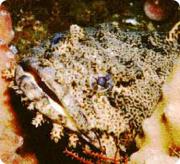Radio Program
Our regular Science and the SeaTM radio program presents marine science topics in an engaging two-minute story format. Our script writers gather ideas for the radio program from the University of Texas Marine Science Institute's researchers and from our very popular college class, Introduction to Oceanography, which we teach to hundreds of non-science majors at The University of Texas at Austin every year. Our radio programs are distributed at to commercial and public radio stations across the country.
It sounds like something that’s advertised in the back of a comic book: a flashlight that only you and your family can see, allowing you to send messages and identify friend and foe in the dark!
But this flashlight is found on the face of one of the scariest-looking creatures in the deep ocean: a black dragonfish. It’s not very big, but it has a wide mouth filled with long, sharp teeth.
There are several species of dragonfish, and like most other deep-sea organisms, they produce their own light to help them find prey, avoid predators, and attract mates.
When a powerful tsunami slammed into the coast of India in December of 2004, it killed thousands. Yet even though it was directly in the tsunami’s path, the town of Pondicherry was spared -- protected by a seawall that was started by French engineers almost three centuries earlier.
Seawalls have been protecting coastal settlements for thousands of years. They can prevent flooding during hurricanes, and prevent the beach from eroding into the sea.
When a starfish moves along the bottom of the ocean, it almost looks like it’s gliding. It’s not, though -- it’s walking on hundreds of tiny “legs” that are powered by seawater.
The starfish -- more correctly known as a sea star -- is propelled by a network of water-filled tubes and sacs known as the water vascular system. Water enters the sea star through an opening located between two of the creature’s five “arms.” A sieve-like structure inside this opening filters out solid particles.
Shark Bay, at the westernmost tip of Australia, is like a land that time forgot. It’s home to a host of plant species that are found nowhere else, several endangered species of mammals, and rock-building microbes like those that inhabited Earth three-and-a-half billion years ago. What it doesn’t have much of is people, and that’s one reason why it has so much of everything else.
The region covers several thousand square miles. It’s far away from any big cities, and only a couple of thousand people live along its thousand miles of coastline.
Marine organisms have many ways of getting around. They wiggle, flap, crawl, or undulate. And some go high-tech: they use jet propulsion.
The marine jet set includes jellyfish, squid, and octopus. All of them create jet thrust by squirting water at high speed, like compressed air squirting out the back of a jet engine.
The deadliest hurricane in U.S. history slammed into Galveston, Texas, on September 8th, 1900. It killed an estimated 8,000 people. Despite its infamy, though, there’s no formal name for the hurricane. At the time, there was no procedure for naming such storms.
It’s almost not fair. The top predators in the oceans -- great white sharks and some of their kin -- have an extra sense to help them find and track prey: the ability to detect the tiny electrical fields that are generated by all living organisms.
Most sharks have keen senses that allow them to track prey, predators, and mates at varying distances. At close range, they also rely on a network of sensors known as ampullae of Lorenzini, named for the Italian scientist who discovered them more than three centuries ago.
A school of fish often looks like a marching band following a drum major. The entire school maneuvers as a single unit, with everyone turning at almost the same instant.
The fish aren’t following instructions, although they are following a leader. They respond so quickly because of a system that’s a lot like the workings of our inner ears.
The system is known as a lateral line -- small sensory organs arrayed around the fish’s head and in lines across both sides of its body.
Don’t judge a fish by its beauty.
Consider, for example, the toadfish. The name comes from its resemblance to a toad -- bulging eyes, wide head, and warty-looking skin. There are more than 80 species around the world, and many of them live in the mud and muck at the bottom of shallow waters. And some of them even grunt like a toad when they’re scared, mad, or courting.
The world’s longest mountain range is almost completely hidden from sight. It snakes 10,000 miles along the bottom of the Atlantic Ocean, and peeks into view in only a few places.
One of those is a tiny group of islands known as Saint Peter and Saint Paul’s Archipelago. It’s near the equator, about 600 miles off the coast of Brazil. It consists of about half a dozen islands plus a few small clumps of rock. The entire group has just four acres of land area.



